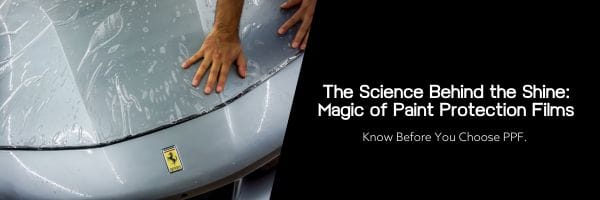
For car enthusiasts, a pristine paint job is a source of immense pride. It reflects countless hours of care and dedication. But the reality of the road – flying debris, scratches, and environmental damage – can quickly turn that pride into frustration. Enter paint protection film (PPF), a technological marvel that acts as an invisible shield for your car’s exterior. This blog delves into the fascinating science behind PPF, exploring its composition, properties, and how it safeguards your car’s precious paintwork.
The Superhero Material: Unveiling the Power of TPU
At the heart of PPF lies a remarkable material called thermoplastic polyurethane (TPU). Imagine a material that’s both strong and flexible – that’s TPU! Here’s a closer look at the key scientific properties of TPU that make it the perfect candidate for PPF:
Beyond Basic Protection: The Multifaceted Functionality of PPF
The science behind PPF goes beyond just its material composition. Modern PPF films are engineered with a range of functionalities to offer a multitude of benefits for your car’s exterior:
The Art of Adhesion: How PPF Bonds with Your Car
For PPF to effectively protect your car, it needs to adhere flawlessly to the paintwork. Here’s where the science of adhesives comes into play:
Conclusion: Unveiling the Invisible Shield for Your Car
The science behind paint protection film (PPF) is truly impressive. From the remarkable properties of TPU to the intricate functionalities of adhesives, PPF offers a comprehensive shield for your car’s precious paintwork.
In the next part of this blog, we’ll explore the different grades of PPF available, along with the science behind their varying thicknesses and how to choose the right one for your car. We’ll also delve into the art and science of PPF application for

Watch as water beads off the deck with our super hydrophobic coatings.

Protect the paintwork from UV damage and keep its vibrant colour despite the conditions.

Let the fear of a rough docking be a thing of the past with a 10H coating.

With minimal maintenance, our products are guaranteed to provide protection for years to come.

With our chemical and contaminant resistant coating, the surface is kept clean. Needing only minor occasional maintenance.

Trusted in 70+ countries, Onyx Coating is the top choice for professionals and car owners seeking premium protection.

Our ceramic coatings adhere to the surface making it resistant to corrosion and oxidation and contamination-free.

Bonds tight with the surtace to maintain a uniform cover and protect the surface evenly.
If you are interested in our products or keen to work with us, send us a message and we will get in contact with you to schedule a quick call or contact us via our email info@onyxcoating.com
Once this information has been received our team will review the accounts and get into contact with you.
With the world’s first N1 nano coating product under our name, we are one of the most advanced automotive protection providers in the market.
Sign up for the latest offers & promotions




© ONYX COATING 2025. All Rights Reserved.